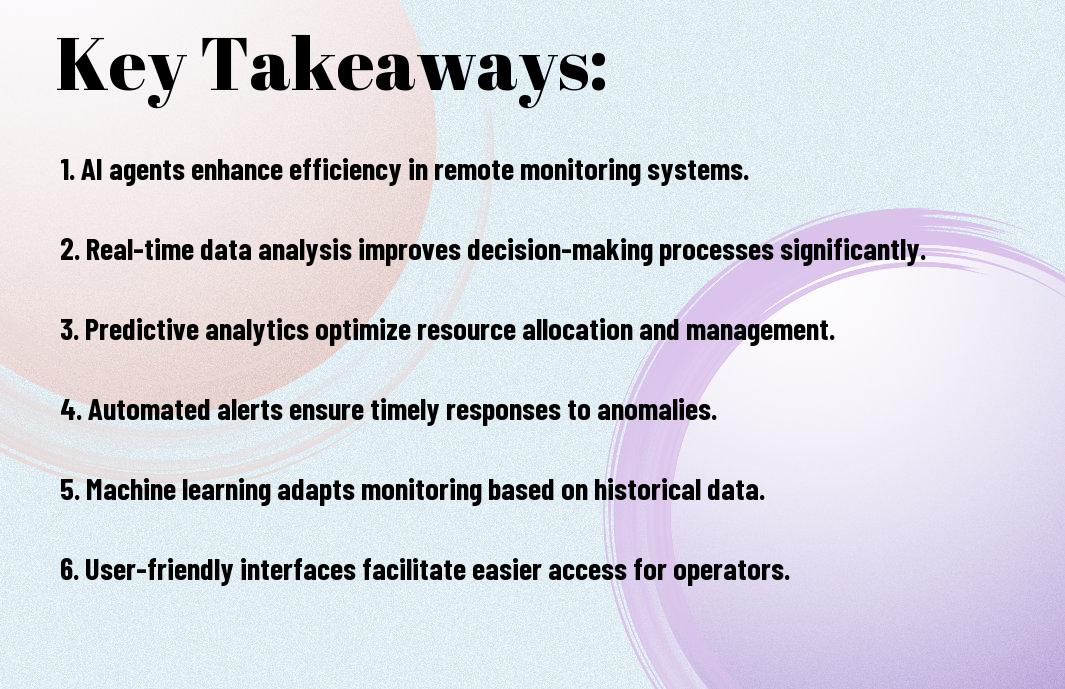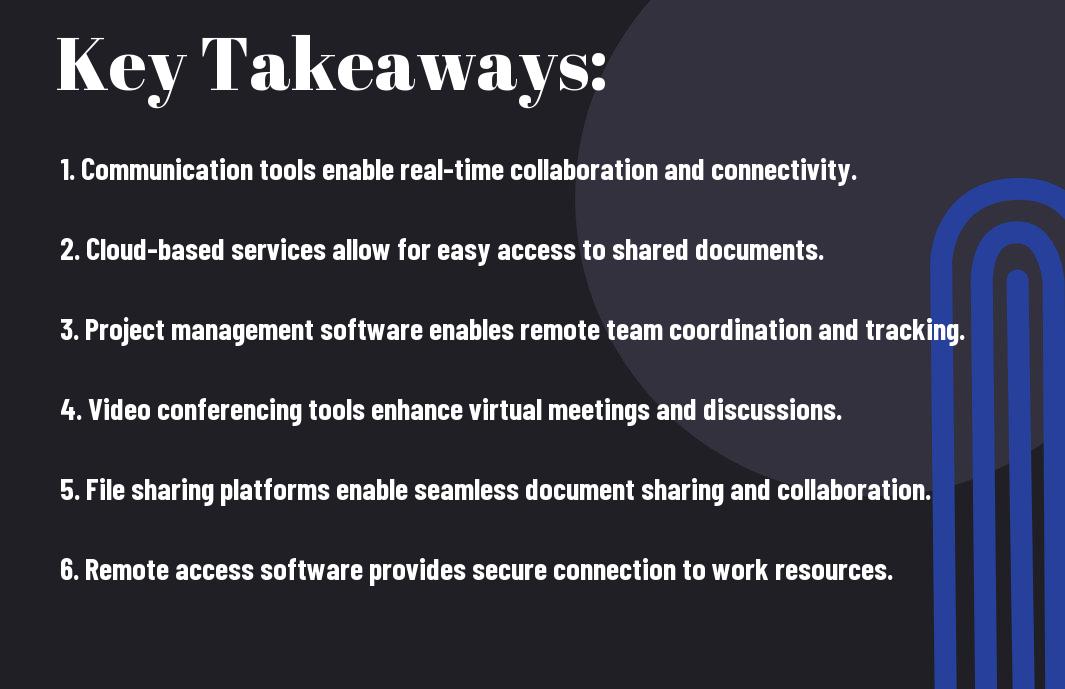As you explore the latest advancements in technology, you’ll find that AI agents are revolutionizing the way you approach remote monitoring. Your ability to track and analyze data remotely is becoming more efficient, thanks to artificial intelligence. For instance, you can learn more about Remote patient monitoring with AI – Artificial Intelligence +, and discover how AI agents are enhancing your capabilities in various industries, enabling you to make more informed decisions and drive innovation forward.
Key Takeaways:
To understand the impact of Artificial Intelligence (AI) on remote monitoring, consider the following points:
- Automation and Machine Learning (ML) algorithms enable AI agents to analyze vast amounts of data in real-time, allowing for more efficient and accurate monitoring of remote systems and equipment.
- The integration of Internet of Things (IoT) devices with AI agents enhances remote monitoring capabilities, enabling the collection and analysis of data from various sources and improving overall Decision-Making processes.
- Advanced Analytics and Predictive Maintenance capabilities of AI agents can help identify potential issues before they occur, reducing downtime and increasing the overall Efficiency of remote monitoring operations.
The Rise of AI Agents
For years, you’ve been witnessing the emergence of AI agents in various industries, and now they’re transforming remote monitoring. You can expect significant improvements in the way you manage and analyze data, leading to better decision-making and increased productivity.
Increased Efficiency in Remote Monitoring
Any organization adopting AI agents can experience streamlined processes and reduced manual labor, allowing you to focus on high-priority tasks and improve your overall efficiency in remote monitoring.
Enhanced Data Analysis Capabilities
Along with improved monitoring, AI agents provide you with advanced data analysis capabilities, enabling you to gain deeper insights into your operations and make data-driven decisions to enhance your business.
Another significant benefit of AI agents is their ability to process vast amounts of data quickly and accurately, providing you with real-time insights and enabling you to respond promptly to changes or issues, thereby minimizing downtime and optimizing your operations. As you explore the potential of AI agents, you’ll find that they can be tailored to your specific needs, making them an invaluable tool in your remote monitoring strategy.
Key Applications of AI Agents
Assuming you’re interested in exploring the various uses of AI agents, you’ll find that they have a wide range of applications. You can utilize them in remote monitoring, predictive maintenance, and healthcare diagnostics, among other fields. As you probe deeper, you’ll discover that AI agents are revolutionizing these industries with their advanced capabilities.
Predictive Maintenance in Industrial Settings
For instance, you can use AI agents to detect potential equipment failures, allowing you to take proactive measures to prevent downtime. You’ll be able to schedule maintenance tasks more efficiently, reducing costs and increasing overall productivity in your industrial setting.
Healthcare Monitoring and Diagnostics
Diagnostics play a significant role in healthcare, and AI agents are transforming this field. You’ll find that AI-powered systems can analyze medical data, identify patterns, and provide insights that aid in diagnosis and treatment. Your healthcare provider can use these tools to make more accurate diagnoses and develop personalized treatment plans.
And as you explore the application of AI agents in healthcare monitoring and diagnostics, you’ll discover that they can help you track patient health remotely, detecting any anomalies or changes in real-time. You’ll be able to receive timely interventions, and your healthcare provider can adjust treatment plans accordingly, leading to better health outcomes and improved quality of life.
Technical Advancements
Keep in mind that technical advancements are driving the evolution of remote monitoring. You’ll see significant improvements in your ability to collect and analyze data.
Machine Learning Algorithms and AI Integration
One of the key factors is the development of machine learning algorithms that enable your AI agents to learn from data and make informed decisions.
Internet of Things (IoT) and Sensor Technology
Sensory devices are becoming increasingly important in remote monitoring, allowing you to collect data from various sources and enabling your AI agents to make more accurate decisions.
Technical innovations in IoT and sensor technology are expanding your possibilities for remote monitoring. You can now deploy sensors in various locations, collecting data on everything from temperature and humidity to motion and vibration. This data is then transmitted to your AI agents, which analyze it and provide you with valuable insights, enabling you to take proactive measures to prevent issues and improve overall efficiency.

Benefits and Advantages
All the advantages of AI agents in remote monitoring are evident when you consider the broader impact of AI on your work. You can learn more about How AI is Shaping the Future of Remote Work and Virtual Teams and its benefits.
Improved Accuracy and Reliability
Between the lines of code and complex algorithms, you’ll find that AI agents improve your monitoring systems’ accuracy and reliability, allowing you to make informed decisions.
Cost Savings and Increased Productivity
Any investment in AI agents for remote monitoring will yield significant cost savings and increased productivity for your organization, as you’ll be able to automate tasks and allocate resources more efficiently.
Increased productivity is one of the primary benefits you’ll experience when implementing AI agents in your remote monitoring systems, as they can process vast amounts of data, identify patterns, and alert you to potential issues before they become major problems, saving you time and resources.
Challenges and Limitations
To ensure the successful implementation of AI agents in remote monitoring, you must consider the potential challenges and limitations that may arise, which can impact the effectiveness of your monitoring system.
Data Security and Privacy Concerns
Concerns about data security and privacy are significant when using AI agents for remote monitoring, as you will be dealing with sensitive information that requires protection from unauthorized access and breaches.
Technical Complexity and Implementation Issues
Privacy issues aside, you will also face technical challenges when implementing AI agents, as you will need to integrate them with your existing infrastructure and ensure they can communicate effectively with other systems.
Indeed, as you research deeper into the technical aspects of AI agent implementation, you will encounter issues related to compatibility, scalability, and reliability, which can be time-consuming and costly to resolve, but addressing these challenges will be necessary to maximizing the benefits of AI-powered remote monitoring for your organization.
Future Developments and Trends
Once again, you will see AI agents playing a significant role in shaping the future of remote monitoring, as they continue to evolve and improve, enabling more efficient and effective monitoring systems, and you can expect to see significant advancements in this field in the coming years.
Integration with Emerging Technologies
Any innovation in AI agents will likely involve integration with emerging technologies, such as the Internet of Things (IoT) and edge computing, allowing you to leverage the benefits of these technologies to enhance your remote monitoring capabilities.
Potential Applications in New Industries
Beside the industries that already utilize remote monitoring, you will see AI agents being applied in new fields, such as healthcare and environmental monitoring, where their capabilities can be leveraged to improve outcomes and decision-making.
Emerging industries such as smart cities and autonomous vehicles will also benefit from AI-powered remote monitoring, enabling you to analyze vast amounts of data in real-time, and make data-driven decisions to optimize performance, safety, and efficiency, and as you explore these applications, you will realize the vast potential of AI agents in transforming your industry.

Summing up
From above, you can see how AI agents are transforming your approach to remote monitoring. As you move forward, your ability to analyze data and make informed decisions will be enhanced by these intelligent systems. You will be able to respond quickly to issues, improving your overall efficiency and productivity. Your business will benefit from the insights and automation provided by AI agents, shaping the future of remote monitoring and taking your operations to the next level.
FAQ
Q: What is the role of AI agents in remote monitoring and how are they transforming the industry?
A: AI agents are playing a significant role in remote monitoring by enabling real-time data analysis, predictive maintenance, and automated decision-making. They are transforming the industry by increasing efficiency, reducing costs, and improving the accuracy of monitoring systems. With the help of machine learning algorithms and IoT sensors, AI agents can collect and analyze vast amounts of data from remote locations, detect anomalies, and send alerts to operators, allowing for prompt action to be taken. This is revolutionizing the way industries such as healthcare, manufacturing, and energy management approach remote monitoring.
Q: How do AI agents improve the accuracy of remote monitoring systems?
A: AI agents improve the accuracy of remote monitoring systems by using advanced machine learning algorithms to analyze data from various sources, including sensors, cameras, and other IoT devices. These algorithms can detect patterns and anomalies that may not be apparent to human operators, allowing for more accurate detection of issues and more effective predictive maintenance. Additionally, AI agents can learn from experience and adapt to changing conditions, further improving their accuracy over time. This enables organizations to make data-driven decisions and take proactive measures to prevent equipment failures, reduce downtime, and optimize performance.
Q: What are the benefits of using AI agents in remote monitoring for healthcare applications?
A: The benefits of using AI agents in remote monitoring for healthcare applications are numerous. AI agents can help healthcare professionals monitor patients remotely, reducing the need for hospitalizations and improving patient outcomes. They can also analyze large amounts of medical data, detect early warning signs of disease, and provide personalized treatment recommendations. Additionally, AI agents can help healthcare organizations streamline clinical workflows, reduce costs, and improve patient engagement. With the help of AI-powered remote monitoring systems, healthcare professionals can provide more effective and efficient care, leading to better health outcomes and improved quality of life for patients.
Q: How do AI agents enhance the security of remote monitoring systems?
A: AI agents enhance the security of remote monitoring systems by providing real-time threat detection and alerting operators to potential security breaches. They can analyze network traffic, system logs, and sensor data to identify suspicious activity and detect anomalies that may indicate a security threat. AI agents can also help organizations comply with regulatory requirements and industry standards by providing automated incident response and remediation. Furthermore, AI-powered remote monitoring systems can use machine learning algorithms to identify and mitigate potential vulnerabilities, reducing the risk of cyber attacks and data breaches.
Q: What is the future outlook for AI agents in remote monitoring and what can we expect in the coming years?
A: The future outlook for AI agents in remote monitoring is promising, with significant advancements expected in the coming years. As AI technology continues to evolve, we can expect to see more widespread adoption of AI-powered remote monitoring systems across various industries. AI agents will become more sophisticated, enabling more accurate and effective monitoring, predictive maintenance, and decision-making. Additionally, the integration of AI with other emerging technologies such as 5G, edge computing, and the Internet of Things (IoT) will further enhance the capabilities of remote monitoring systems, enabling new applications and use cases that we cannot yet imagine. As a result, organizations can expect to see improved efficiency, reduced costs, and increased competitiveness in their respective markets.



